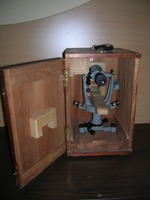  | Click to enlarge |
|
Structure of mechanism |
| Function |
This device is housed in a wooden case with wedges and a sliding console. It also contains a cord, at the end of which is fixed a conical metallic weight and a marker consisting of a disc and a rod. These two elements are attached to a tripod. The marker is set at one of the apexes of the triangle defined for the measurement. The plumb line is attached to the tripod flange and hangs vertically from the marker. The instrument comprises a sighting telescope with an eyepiece and an object lens. This is mounted on a horizontal axis and can pivot in the vertical plane. There is no angle measurement disc associated with this rotation, which is simply used to adjust the sighting with respect to the altitude of the point. The base is a tripod with three blocking screws, which enable the device to be levelled. This parameter can be verified by a cylindrical spirit level located on one of the brackets. Two clasps fix the telescope to the two mounting brackets. A screw on the axis is used to block rotation. At the base of the two brackets there is there is a circular plate which can turn in the horizontal plane and on which the measuring disc is located. The angle values are visible thanks to two lateral eyepieces fixed to the plate. A knob is used for fine rotation adjustment. A screw located on the edge of the plate enables the graduated disc to be blocked and unblocked. |
| |
Guidance function |
| Trace of a dedicated point on follower |
 Open trace Open trace |
| Dimension of mechanism |
spatial |
| |
Application |
| Examples of application |
The alignment circle enables angles to be measured only in the horizontal plane.
The telescope can pivot in the vertical plane but this rotation is used solely to aim at a target situated at a different altitude from the station, and not for angle measurement. The angles in the horizontal plane are used to calculate distances which are inaccessible by direct measurement on the ground. These values are then used in topography to lay out a building or produce plans.
Given three reference points which are easily identifiable on the ground, forming the three points of a triangle, a distance defined by one of the sides of the triangle can be obtained if the values of two angles and one of the other sides are known. The device enables sightings to be made to measure the values of the two required angles.
For each measurement it is necessary to verify that the device, fixed to a tripod, is horizontal. This is done using the footscrews and the spirit level. The device is placed at the apex of one of the angles of the triangle and the other two apexes are targeted to obtain the first angle. Before the first sighting, the vernier on the graduated circle is set to zero, and the angle disc is blocked with the set screw. After the sighting at the first apex, the disc is freed (by unblocking the screw), the telescope is turned towards the second apex, and the angle is read via one of the lateral eyepieces. |
| |
|

 Images
Images

 Images
Images